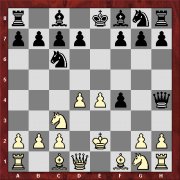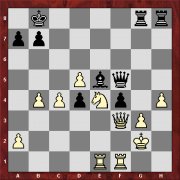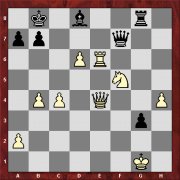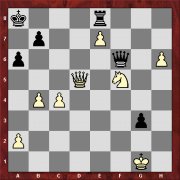 |
Book Reviews |
Last updated 25 October 2004

| index |
50 Golden Chess Games

by Tim Harding
Introduction
Tim Harding has recently released 50 Golden Chess Games, a sequel to 64 Great Chess Games, published in 2002, and reviewed here in issue 79. The book is the same size as Harding's most recent Red Letters (B5 format, 16x24cm), and, happily, is again stitch-bound. It has 272 pages covering a wide variety of CC games played from the 19th to the 21st centuries. The presentation format is similar to 64 Great Chess Games, but worth noting is the greater depth of analysis, particularly the opening phases, where previous annotations have often been critically re-visited.
Sample Game
Here is a game from the book, featuring George Brunton Fraser, a Scot who organised the first UK Correspondence Team Tournament from 1887-89. The annotations reproduced here are but a fraction of those you will find in the volume itself.
The Players
G B Fraser (1831-1905), from Fife, was a major figure in 19th century Scottish chess. From as early as 1851, he was involved in CC games played by Dundee. He helped to organise, and played in, the international tournament organised in 1867 by Dundee Chess Club (Scotland's third oldest). By that date, an attack in the Evans Gambit was already named after him.
From 1887-1896, Fraser organised several tournaments, including the one described below. In 1896, he published
a book recording 200 games from these events, although unfortunately he did not include result lists or state
specifically to which event and year each game belonged.
[Editor's note: the copy of 200 Correspondence Games loaned to Tim for his research, was provided by Roald
Berthelsen of Norway, currently playing in the Douglas Livie Memorial Invitation tournament.]
The culmination of Fraser's career came when he won the Scottish Championship in 1898: his 67th year!
G F Barry, a founder member of the City and County of Dublin Chess Club in 1867, was one of the strongest Irish players up to the time of his death in 1891. His British Chess Magazine obituary says that he was also a noted cricketer.
About the Opening
Fraser loved laying in gambit style; soundness seems to have been a secondary consideration to excitement for him. Probably he was so much stronger than the majority of his opponents that he could usually recover from mistakes and extravagant innovations.
Steinitz had introduced his outrageous gambit, with its bold king march, at the Dundee 1867 tournament, and Fraser was clearly fascinated with it from then onwards. White's 8th move was inferior, but Black missed his opportunity.
About this Game
The BCM for November 1889 reported the finish of the event and it gave the scores of the leaders. The event was a round robin, with six representatives of each country (though some games were unfinished). Fraser himself was the winner, with Barry half a point behind, well ahead of masters J H Blake and W H Gunston.
Ireland scored the most points (47/94), but England had the best percentage (45/84), while Scotland scored 45/94. Conclusive evidence is lacking, but it seems probable that Barry played in no other Fraser tourneys, and that this therefore was the decisive game for individual honours in the triangular team tournament.
| Fraser, G B - Barry, G F [C25] UK Correspondence Tourney, 1887-89 [Abbreviated Notes by Fraser and Harding] | |
| 1.e4 | e5 |
| 2.Nc3 | Nc6 |
| Black can avoid the gambit by 2...Nf6 | |
| 3.f4 | exf4 |
| 4.d4 | Qh4+ |
| 5.Ke2 | |
 | |
| Several books mention the Steinitz Gambit, but only give a partial view of it. Readers may wish to consult the CD 'The Collected Works of Wilhelm Steinitz', edited and published by Sid Pickard. That includes a survey and database of the gambit compiled by R Leininger, which has much new analysis and obscure games, although it doesn't take account of some of the books written on the Vienna. | |
| 5... | d5?! |
| It is natural to want to open the centre and get at the White king, but this proves not so easy to do; sacrificing the d-pawn usually plays into White's hands. Nowadays players tend to prefer 5...d6 or; 5...b6 | |
| 6.Nf3 | |
| This is a move order trick; the usual line is 6.exd5 Bg4+ 7.Nf3 0-0-0 The text just amounts to a transposition, but Fraser probably wanted to see if Black would try something else at move 6 or 7. | |
| 6... | Bg4 |
| 7.exd5 | 0-0-0 |
| Black offers a knight for rapid development and open lines; he is committed to this by his 5th move. White should accept the material; then Black will at best get a draw. | |
| 8.Bxf4 | Bxf3+ |
| 9.Kxf3 | Qf6 |
| 10.g3 | Nxd4+ |
| 11.Kg2 | h5 |
| 12.Bd3 | g6?! |
| Black already faces a crisis. This move creates two retreat squares: one for the queen at g7 and another for the knight at f5. | |
| 13.Rf1 | Qg7 |
| 14.Be3?! | |
| 14.Qe1 (idea Be5) is much stronger, and after 14...f6 15.Rd1 White has all his pieces in play with a huge lead in development. | |
| 14... | Nh6? |
| 15.Bxg6 | c5 |
| Fraser did not explain why he thought that this was much better than taking the bishop. Maybe he intended to meet 15...Qxg6!? by 16.Bxd4 ( 16.Qxd4 h4!?) and Black has plenty of tactical play. | |
| 16.Bxh5 | |
| White is now two pawns up, but Barry fought hard for another 45 moves. | |
| 16... | Bd6 |
| 17.Bxd4 | cxd4 |
| 18.Ne4 | Be5 |
| 19.c4 | f5 |
| Black decides to stir up kingside complications and keep his passed pawn rather than take en passant on c3. | |
| 20.Nc5 | Rdg8 |
| 21.Qf3 | Qh7 |
| 22.Rae1 | Bd6 |
| 23.b4? | |
| White should be trying to consolidate into an endgame. 22.Nd3 looks strong, but who knew about blockading knights in 1888? | |
| 23... | f4? |
| Fraser obviously wanted his knight on e4 so Black should have found a constructive waiting move like 23... Kb8! | |
| 24.Ne4 | Be5 |
| 25.h4!? | |
| Shields h2-h3 and plans his 28th move. | |
| 25... | Nf5 |
| 26.Bg4 | Kb8 |
| 27.Bxf5 | Qxf5 |
 | |
| 28.Ng5! | |
| 'White has now got comparative freedom' - Fraser. | |
| 28... | Bc7 |
| This is objectively best, but 28...Rxg5?! might have pulled off a swindle. | |
| 29.Rf2 | Qd7?! |
| 30.Rfe2 | fxg3 |
| 31.Qf7 | Qc8 |
| 32.Re6 | Rf8 |
| 33.Qg7 | d3! |
| Black keeps the game alive, but Fraser manages to retain control. He plans to roll his queenside pawns and stifle the Black bishop. White will pick up the d-pawn when he can, but leave the g-pawn as shelter for his king. | |
| 34.Nf3 | Bf4 |
| 35.Qd4 | d2 |
| 36.Rh1 | Rh5 |
| 37.Rf1 | Rhf5 |
| 38.Qe4 | |
| 'Enabling him to take the advanced pawn with safety' - Fraser. | |
| 38... | Bc7 |
| 39.Nxd2 | Rxf1 |
| 40.Nxf1 | Rf2+ |
| 41.Kg1 | Rf4 |
| 42.Qg6 | Rf8 |
| 43.Ne3 | Rg8 |
| 44.Qe4 | Qf8 |
| 45.Nf5 | Bd8 |
| 46.d6 | Qf7 |
 | |
| 47.Re7! | |
| 'The play all through is very instructive' - Fraser. | |
| 47... | Bxe7 |
| 48.dxe7 | Re8 |
| 49.Qe5+ | Ka8 |
| 50.Qd5 | Qf6 |
| 51.h5 | |
| Black's rook is totally passive, the passed pawns are very dangerous, and White controls enough key squares to ensure victory. | |
| 51... | a6 |
| 52.h6 | |
 | |
| 52... | Qc3 |
| 'A promising move for perpetual check, but White has provided for this eventuality' - Fraser. | |
| 53.Kg2 | Qe1 |
| 54.Qd8+ | Ka7 |
| 55.Qd4+ | Ka8 |
| 56.h7 | Qe2+ |
| 57.Kxg3 | Qe1+ |
| 58.Kf4 | Qf1+ |
| 59.Kg5 | Qg2+ |
| 60.Kf6 | Rc8 |
| 61.Qd8 | 1-0 |
Conclusion
I am always favourably impressed by the sheer diligence by which Tim assembles his material - he manages to combine being prolific with thorough research - and this publication continues his very high standards.
As ever, Tim has done well to persuade some of the best-known CC luminaries to add their wisdom, and the book contains annotations by Hamarat, Timmerman, Baumbach, Berliner, Umansky, Maliangkay, Zilberberg, Rause, Geenen, and Estrin, to name but a few!
Linking the in-depth analysis of variations (particularly in the openings), there is a lucid writing style that clearly explains the motivations of the players at key stages, and relates some nice anecdotes in the passing.
It doesn't matter if your rating is high, low or somewhere in between, you will derive great pleasure from playing through this cleverly chosen collection.!
Red Letters sells at £16.99, or 25 euros. With p&p, this becomes £18.99 or 28 euros. I thoroughly recommend you go for gold and invest your money!
You can find out more at the Chess Mail website or write to Chess Mail at 26 Coolamber Park, Dublin 16, Ireland. Other stockists are also selling the book - you should quote ISBN 0-9538536-7-5.